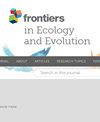与其他工蜂亚群相比,无刺蜂的觅食者会经历更多的热应激微气候,并具有更宽的热耐受广度
IF 2.4
3区 环境科学与生态学
Q2 ECOLOGY
引用次数: 0
摘要
导言人类活动引起的气候变化的现状尤其令热带昆虫担忧,据预测,热带昆虫是受负面影响最大的物种。研究社会性昆虫对气候的耐受性具有挑战性,因为适应性存在于个体和社会两个层面。分工研究有助于弥合我们在不同尺度上对这些适应性的理解之间的差距,这一点非常重要,因为社会性昆虫在全球动物生物量、生物多样性和生态系统服务中占有巨大的比重。考虑个体生理如何构建群体层面的适应性,可以改善对社会物种的气候变化影响评估。Tetragonisca angustula是一个新热带无刺蜂物种,它表现出高度的工蜂亚种姓专业化和形态独特的士兵种姓。我们测量了小体型觅食者和两个士兵亚群(盘旋守卫和站立守卫)的热耐受性(CTmax和CTmin)。结果与讨论尽管觅食者和守卫之间存在体型差异,但没有观察到热上限或热下限的差异。然而,觅食者的平均耐热广度明显大于守卫者,而且觅食地点的温度变化比筑巢地点大,这在小气候尺度和分工背景下支持了气候多变性假说。与盘旋和站立的警卫相比,小体型觅食者的耐暖性明显较低。耐暖性的大小表明,在这种环境中,即将受到气候变化影响的风险较低,但也表明,气温的升高和热浪的盛行可能会使觅食动物先于其他亚群达到其耐暖上限。与挑战临界温度相比,觅食发生的温度范围更窄,早晨的活动量更大。温度的定向上升可能会将这些首选觅食温度限制在更窄的时间窗口内。要弄清觅食者如何随着人为变暖而改变活动时间,还需要进一步的研究,但气候的变化可能会影响自然和农业系统中的植物授粉率。本文章由计算机程序翻译,如有差异,请以英文原文为准。
Stingless bee foragers experience more thermally stressful microclimates and have wider thermal tolerance breadths than other worker subcastes
IntroductionThe current state of anthropogenic climate change is particularly concerning for tropical insects, species predicted to be the most negatively affected. Researching climatic tolerance in social insects is challenging because adaptations exist at both individual and societal levels. Division of labor research helps to bridge the gap between our understanding of these adaptations at different scales, which is important because social insects comprise a tremendous portion of global animal biomass, biodiversity, and ecosystem services. Considering how individual physiologies construct group-level adaptations can improve climate change impact assessments for social species. Tetragonisca angustula is a neotropical stingless bee species that exhibits high worker subcaste specialization with a morphologically distinct soldier caste.MethodsWe used this species to investigate 1) whether age- and size-differentiated subcastes differ in thermal tolerance, 2) which worker subcaste operates closest to their thermal limits, and 3) the extent to which this species selects active foraging times to offset thermal stress. We measured the thermal tolerance (CTmax and CTmin ) of small-bodied foragers and two soldier subcastes (hovering guards and standing guards) in T. angustula .Results and discussionDespite body size differences between foragers and guards, no differences in the upper or lower thermal limits were observed. However, the average thermal tolerance breadth of foragers was significantly larger than that of guards, and foraging sites were more thermally variable than nest sites, supporting the Climatic Variability Hypothesis at a microclimate scale and in the context of division of labor. Warming tolerance was significantly lower among small-bodied foragers compared to hovering and standing guards. The magnitude of warming tolerances indicated low risk of imminent climate change impacts in this environment but suggests that increasing temperatures and heatwave prevalence may cause foragers to meet their upper thermal limits before other subcastes. Foraging occurred at a narrower range of temperatures than would challenge critical temperatures, with higher morning activity. Directionally increasing temperatures will likely confine these preferred foraging temperatures to a narrower time window. Further study is needed to elucidate how foragers may shift times of activity in response to anthropogenic warming, but changing climates may impact plant pollination rates in natural and agricultural systems.
求助全文
通过发布文献求助,成功后即可免费获取论文全文。
去求助
来源期刊

Frontiers in Ecology and Evolution
Environmental Science-Ecology
CiteScore
4.00
自引率
6.70%
发文量
1143
审稿时长
12 weeks
期刊介绍:
Frontiers in Ecology and Evolution publishes rigorously peer-reviewed research across fundamental and applied sciences, to provide ecological and evolutionary insights into our natural and anthropogenic world, and how it should best be managed. Field Chief Editor Mark A. Elgar at the University of Melbourne is supported by an outstanding Editorial Board of international researchers. This multidisciplinary open-access journal is at the forefront of disseminating and communicating scientific knowledge and impactful discoveries to researchers, academics and the public worldwide.
Eminent biologist and theist Theodosius Dobzhansky’s astute observation that “Nothing in biology makes sense except in the light of evolution” has arguably even broader relevance now than when it was first penned in The American Biology Teacher in 1973. One could similarly argue that not much in evolution makes sense without recourse to ecological concepts: understanding diversity — from microbial adaptations to species assemblages — requires insights from both ecological and evolutionary disciplines. Nowadays, technological developments from other fields allow us to address unprecedented ecological and evolutionary questions of astonishing detail, impressive breadth and compelling inference.
The specialty sections of Frontiers in Ecology and Evolution will publish, under a single platform, contemporary, rigorous research, reviews, opinions, and commentaries that cover the spectrum of ecological and evolutionary inquiry, both fundamental and applied. Articles are peer-reviewed according to the Frontiers review guidelines, which evaluate manuscripts on objective editorial criteria. Through this unique, Frontiers platform for open-access publishing and research networking, Frontiers in Ecology and Evolution aims to provide colleagues and the broader community with ecological and evolutionary insights into our natural and anthropogenic world, and how it might best be managed.
 求助内容:
求助内容: 应助结果提醒方式:
应助结果提醒方式:


